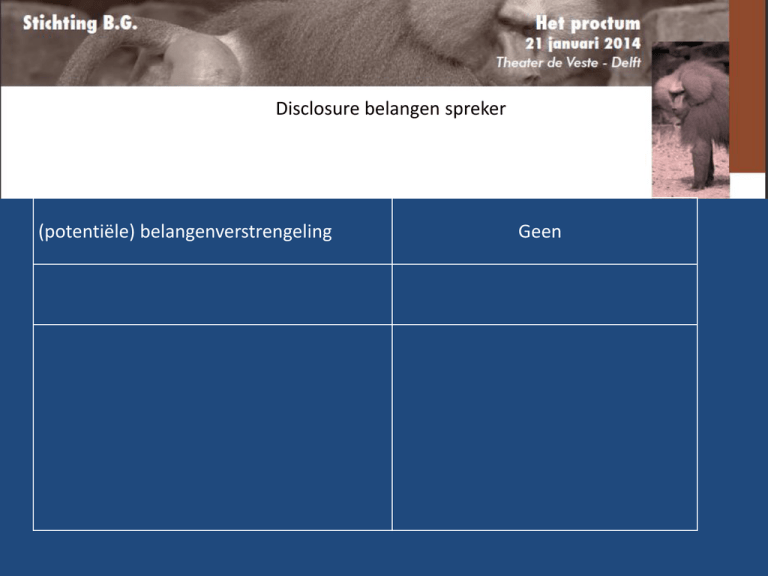
Disclosure belangen spreker
(potentiële) belangenverstrengeling
Geen
Anale fissuur
Fissuur
Fissuur
Een anale fissuur (fissura
ani of anuskloof) is een
klein scheurtje, wondje
of kloofje in het
slijmvlies bij de uitgang
van de anus
Anale fissuur
Br Med J 2012
Incidentie
Man/Vrouw ratio
Leeftijdspiek
1/350
1:1
20-40 jaar
Chronische anale fissuur
• Poor healing rate
• Predilection for
posterior midline (90%)
• Pain out of proportion
• No granulation tissue
Fissuur
Laser Doppler Flowmetrie
Ischaemisch ulcus van de anodermis
British Journal of Surgery 1996, 83,63-65
Ischaemic nature of anal fissure
W. R. SCHOUTEN, J . W. B R I E L , J . J. A. AUWERDA and E. J . R. D E GRAAF
Fissuur
Anal dilatation
• Uncontrolled
• IAS disruption
• Continence
disturbances: up to 50%
1838 (Recamier)
Anal dilatation
Ram et al., RCT (2007)
Follw-up: 1 year
No. patients
Minor incontinence
Major incontinence
Recurrence
AD
55
15%
0%
11%
LIS
53
4%
0%
2%
Lateral internal sphincterotomy
Anal Resting Pressure
200
MARP (cm H2O)*sd
150
100
50
0
Fissure
pre LIS
N=100
Controls
N=51
Fissure
post LIS
N=100
Lateral internal sphincterotomy
• Healing rate > 90%
• Recurrence rate: very low
• Almost immediate pain
relief
• Patient satisfaction: high
Continence disturbances ?
Long-term continence disturbance
after LIS
Garg et al. (2012)
Systematic review
342 studies screened
22 included (n>4500)
2 years or more after LIS
Long-term continence disturbance
after LIS
Overall continence disturbance
14%
Incontinence for gas
Soiling
Incontinence for stool
9%
6%
<1%
Long-term continence disturbance
after LIS
Risk facors
• Female gender
• History of vaginal
delivery
• Anterior fissure
Alternative
• Fissurectomy with or
without anoplasty
• Fissurectomy with
chemical
sphincterotomy
Fissurectomy with anoplasty
Abramowitz et al. (2013)
N= 246
Follow-up: ˃ 1 year
Healing: 100%
Recurrence: 0%
De novo cont. disturbances: 7%
Fissurectomy with ISDN
Engel et al. (2002)
•
•
•
•
•
N=17
Follow-up: > 2 years
Healing: 100%
Recurrence: 0%
Continence: ?
Fissuur
Relaxatie interne sphincter
• Exogenous NO donors
Glyceryl Trinitrate (GTN)
Isosorbide Dinitrate (ISDN)
• Calciumblockers
Diltiazem
Nifedipine
• Botulinum toxin
Botox
GTN vs Diltiazem
Sajid et al. (2011)
Systematic review
7 RCT’s
481 patients
Diltiazem
Lower incidence side effects
Lower recurrence
Medicamenteuze Behandeling Fissuur
GTN, ISDN, Diltiazem
Botox
Healing rate
Healing rate
± 60%
± 75%
Botox
Follow-up > 3 years
Recurrence
40-50%
Minguez et al. Gastroenterology 2002
Arroyo et al. Am J Surg 2005
Fissure treatment
First step
Second step
Chemical sphincterotomy
Surgical treatment
• Men, high pressure: LIS
• Female, normal
pressure: fissurectomy


